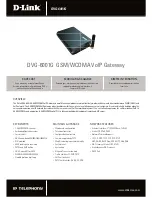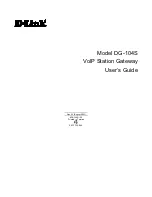
Creating routes
Dialogic® Vision™ CX Video Gateway Administration Manual
Understanding the gateway routing table
Entries in the gateway routing table include from (calling) and to (called) patterns
that are matched against the calling party address and called party address received
for an incoming call. The entries also specify how outgoing addresses are constructed
from incoming addresses.
The called party address and calling party address on the outgoing side of the
gateway are usually strings that contain substitution variables ($1, $2, ….). The
substitution variables represent substrings that are captured from the pattern match
on the incoming calls. For information, see
Routing table expressions
on page 68.
You can specify routing rules for both regular and transferred calls, and you can
define up to 2048 routes.
Routing table fields
The following table describes the fields in the routing table:
Field
Description
ID
Number of the routing rule entry in the ordered list.
To incoming
Regular expression for valid PSTN numbers or valid URIs that signify the called party
on the incoming side of the CX Video Gateway.
From
Regular expression for valid PSTN numbers or valid URIs that signify the calling party
incoming
on the
incoming side of the CX Video Gateway.
Mode
Routing mode for the routing rule entry. Use the Route mode for routing regular calls
and the Transfer mode for routing call transfers.
To outgoing
Regular expression for valid PSTN numbers or valid URIs that signify the called
party
on the outgoing
side of the CX Video Gateway.
Enter
reject
to reject calls that match the routing rule.
From
Regular expression for valid PSTN numbers or valid URIs that signify the calling
party
outgoing
on the outgoing side of the CX Video Gateway.
Video
For implementations with licensed video transcoding ports, determines whether video
transcoder
transcoding is applied to every call or not.
Dynamic
(default value) indicates that video transcoding only applies to calls with
different video codec characteristics such as a different codec or a different picture
frame.
Force
indicates that video transcoding is inserted in the video path regardless of the
negotiated video codec on either endpoint.
For more information about video transcoding, see
Managing video transcoder
resources
on page 94.
64
Dialogic
















































